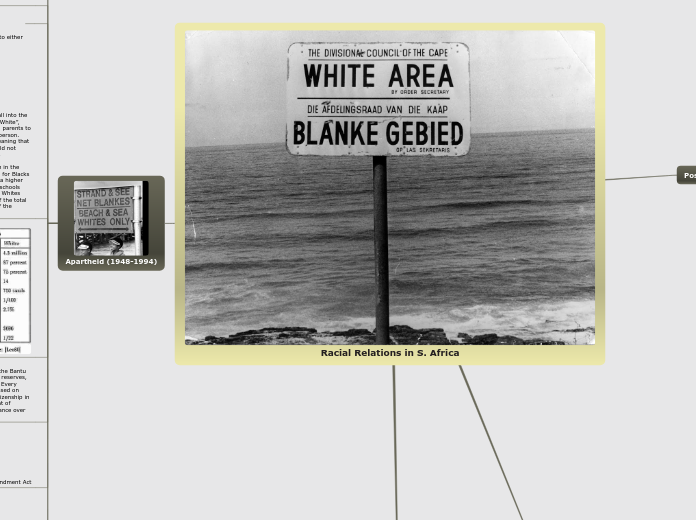jonka raeeze rahman 4 vuotta sitten
515
Racial Relations in S. Africa

jonka raeeze rahman 4 vuotta sitten
515

Lisää tämän kaltaisia
The penalties for protesting were very heavy fines, imprisonment without trial (those who were tried received death sentence, banishment from South Africa, or life imprisonment.
The first slaves to be brought in South Africa were non-muslim slaves from India, which at the time was ruled by Muslims.
There were also other places where slaves were taken from and sent to present-day South Africa, such as Madagascar, where slaves were bought between the years 1731 and 1765.
The majority of Indian South Africans are in KwaZulu Natal, where sentiments against minorities had become increasingly concerning. There are both examples of hate speech and violence against Indians in South Africa. An example of hate speech against South Africans who are of Indian descent is the words of Phumlani Mfeka, a KwaZulu Natal businessman, who is also the spokesman for the "Mazibuye African Forum" published a letter which claimed that Indian South Africans do not have any rights to owning property or citizenship.He had posted on his Twitter account "A Good Indian is a dead Indian". Phumlani Mfeka had also been barred from making remarks against Indians by the South African Court. There had also been attacks on the Chinese community in South Africa.
10 Anti-Semitism in South Africa has been in existence since the 1930's, when the Nazi movement had maintained dominance over Germany from 1933-1945. One of the many reasons of this happening was due to the Germans being an enemy of Great Britain. In South Africa, there were also many sports clubs which had a policy which barred Jews from entering until recently. The D.F. Malan National Party was very closely associated with Nazi laws and policies. One notable action of the D. F. Malan National Party was the Aliens Act, which stopped all Jewish migrants from Eastern Europe from entering South Africa. An area known as District Six was where many Jews had lived, prior to their forced eviction, as the land covering "District Six" would be used for a White-Only development. Hendrick Verwoerd, who had designed the Apartheid in South Africa, had obtained a psychology degree while studying abroad in Germany. H. Verwoerd had also protested allowing Jewish refugees who had come from Germany into South Africa, in the fear that Jewish residents intended to A) Spread communism throughout the world B) Overtake Protestant businessmen. The Aliens Act's definition of Jews was anyone whose parents were of even partial Jewish ancestry, ignoring their religious beliefs. During the Apartheid era, in 1956, Nelson Mandela was tried for treason, accompanied by a group which consisted mostly of Jewish men and women. There were also accusations of the group conspiring to overthrow the current government. Post-Apartheid, there are still examples of Anti-Semitism in South Africa. One notable example is the synagogue bombings, which are believed to have been done by a vigilante group known as P. A. G. A. D. (People Against Gangsterism and Drugs), who are known for killing gangsters and setting fire to their homes. There are other examples, such as the Western Cape Leader, Marius Fransman who, in 2013, claimed that “98% of land and property owners were white and jewish”. Another example was a broadcast by the radio station "Radio 786", who had broadcasted a programme which denied that the Holocaust ever happened.
There have been many incidents of racism against white people, which is often ignored in South Africa. There are some notable incidents of violence against white people, such as one incident which occurred in 2004 where a man had killed and abducted a woman , her daughter, and her daughter's grandmother, due to their race. There have also been notable examples of hate speech, which very often talk about killing and/or torturing white residents in South Africa, such as the leader of the "Economic Freedom Fighters", a political party in South Africa, in 2018 promoted violence against white residents in the country. Another example would be the killings of South African farmers. These events have had many noticeable reactions, such as the internet chatroom "AfriForum" who protested the deaths of the farmers in question, claiming that the attacks were racially motivated. This internet chatroom had also denied that Apartheid was a crime against humanity.
Although there is no legal form of racial segregation, there is still incidents of overt racism in South Africa, such as a real estate agent who had previously lived in Durban, SA, who had made a comparison of black residents entirely to "dirty monkeys who littered on the beaches" , which were previously set aside for use by whites only. The consequences of this were her (the real estate agent) being fined upwards of USD 13,000, two years' prison sentence, multiple death threats, etc. In addition to hate speech, there has also been racially motivated violence against blacks in South Africa, including two white men in 2016 who had violently beaten a black man for allegedly trespassing on private property. The two men had been imprisoned for their crimes, and one of them had also received their sentence for destroying evidence of anything happening in the first place.